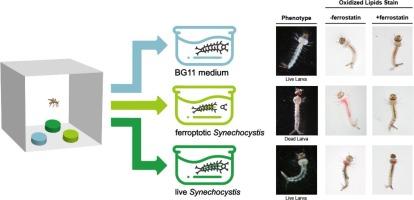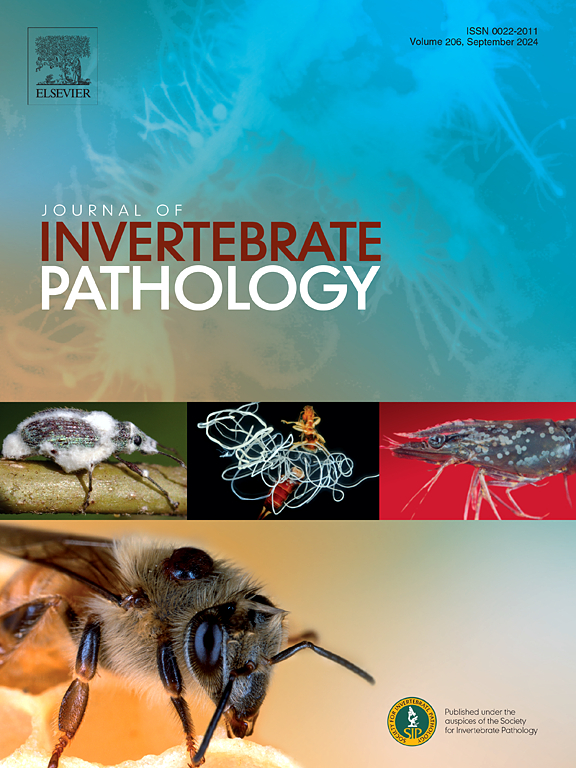Ferroptotic cyanobacteria as biocontrol agent of the southern house mosquito Culex quinquefasciatus
IF 3.6
3区 生物学
Q1 ZOOLOGY
引用次数: 0
Abstract
Culex quinquefasciatus is a hematophagous mosquito, widely distributed around the world, that plays a crucial role in public and veterinary health. As an efficient vector of etiological agents, it exhibits a marked preference for urban environments and human blood. Despite advances in mosquito-borne disease control, managing mosquito populations remains an economically efficient and safe strategy to reduce the impact of epidemic outbreaks. However, achieving this goal requires ecologically acceptable tools that ensure sustainability and minimize adverse environmental impacts. In the present work, we investigated the effect of a non-toxigenic model cyanobacterium on Cx. quinquefasciatus larvae through regulated cell death. We observed that heat stress treatment of Synechocystis PCC 6803 inducing ferroptosis, results in larval lipid oxidation, leading to their death. This effect can be mitigated by rearing larvae in an environment containing canonical inhibitors of ferroptosis, such as ferrostatin 1, or antioxidants, like glutathione and ascorbic acid. Furthermore, larval cell death induced by ferroptotic cyanobacteria is closely linked to oxidative dysregulation and lipid peroxidation, both hallmarks of ferroptosis. Moreover, while ferroptotic Synechocystis significantly affects larval development, it does not influence oviposition site selection by gravid females.

作为南方库蚊生物控制剂的铁蓝藻
库蚊(Culex quinquefasciatus)是一种食血蚊子,广泛分布于世界各地,在公共卫生和兽医卫生中发挥着至关重要的作用。作为病原体的有效传播媒介,它对城市环境和人类血液有着明显的偏好。尽管在蚊媒疾病控制方面取得了进展,但管理蚊子种群仍然是减少流行病爆发影响的一种经济有效且安全的策略。然而,实现这一目标需要生态学上可接受的工具,以确保可持续性并最大限度地减少对环境的不利影响。在本研究中,我们研究了一种无毒模型蓝藻通过调节细胞死亡对五步蛇幼虫的影响。我们观察到,对诱导铁突变的 Synechocystis PCC 6803 进行热应力处理会导致幼虫脂质氧化,从而导致其死亡。将幼虫饲养在含有铁蛋白酶抑制剂(如铁蛋白酶 1)或抗氧化剂(如谷胱甘肽和抗坏血酸)的环境中,可以减轻这种影响。此外,铁突变蓝藻诱导的幼虫细胞死亡与氧化失调和脂质过氧化密切相关,而这两者都是铁突变的标志。此外,虽然铁化蓝藻会显著影响幼虫的发育,但却不会影响怀孕雌虫对产卵地点的选择。
本文章由计算机程序翻译,如有差异,请以英文原文为准。
求助全文
约1分钟内获得全文
求助全文
来源期刊
CiteScore
6.10
自引率
5.90%
发文量
94
审稿时长
1 months
期刊介绍:
The Journal of Invertebrate Pathology presents original research articles and notes on the induction and pathogenesis of diseases of invertebrates, including the suppression of diseases in beneficial species, and the use of diseases in controlling undesirable species. In addition, the journal publishes the results of physiological, morphological, genetic, immunological and ecological studies as related to the etiologic agents of diseases of invertebrates.
The Journal of Invertebrate Pathology is the adopted journal of the Society for Invertebrate Pathology, and is available to SIP members at a special reduced price.

 求助内容:
求助内容: 应助结果提醒方式:
应助结果提醒方式:


